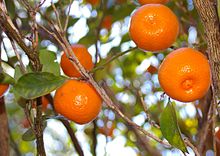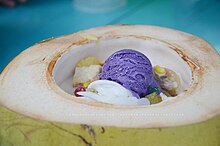Filipino cuisine


The Philippine kitchen combines Spanish - Mexican , Chinese , Indian , Japanese and American influences that the regional cuisines of the different ethnic groups in the Philippines have worked.
eat
Fish and seafood , along with rice, are the staple foods in the Philippines. In the simplest case, fish is simply fried and eaten with rice, which is part of every meal, and vegetables. Sinigang na isda (a sour soup), paksiw (fish simmered with pepper and vinegar) or inihaw (grilled fish) are usually made from larger fish . Prawns , crabs and lobsters are reserved for expensive and exclusive dishes. Clams and snails are traditionally considered poor people's food , although these are also served as delicacies in good restaurants. Kinilaw , raw fish that is marinated in vinegar and made with chopped ingredients like garlic, ginger and chilli in many local recipe variations, is an inexpensive delicacy.
Except in the Islamic regions, pork is also popular. The national dish is adobo , which consists of pork, beef, poultry, fish or vegetables, which is steamed. There are also vinegar, garlic, onions, pepper and, depending on the region, soy sauce or coconut milk. Roasted suckling pig with liver sauce is usually served for festive occasions , known in the Philippines under the Spanish name Lechón . Other popular dishes are grilled meat or fish skewers or air-dried and salted beef ( tapa ), which is fried or grilled and seasoned with nipapalm vinegar. Kare-Kare (oxtail and / or beef in peanut sauce ) is also very popular. The dishes are not as strongly seasoned as in other Asian countries, but a lot of coconut milk is used: This is how Guinatan is created when meat and vegetables are boiled with coconut milk. In the province of Bicol, on the other hand, people like to eat spicy, the so-called Bicol Express, for example, is very similar to Thai curry.
The dumplings filled with meat or vegetables ( Siopao ) are of Chinese origin . Long noodles ( pancit ), which are supposed to symbolize a long life, are served on birthdays . Pancit, like spring rolls ( Lumpia ) or the little Lumpiang Shanghai (Shanghai-Lumpia), are of Chinese origin. Arroz caldo (rice with chicken) has a Spanish name due to the colonial era, but can also be traced back to Chinese influences.
As a snack ( merienda ), there are Spanish dishes such as ensaymada (sweet shortbread with cheese) or pan de sal (small rolls), but also rice cakes such as puto or bibingka . Puto is very often eaten with dinuguan (a soup made from pork and blood). The Chinese dishes Hopia (pastries with bean paste) or Pancit canton (wok noodles) are also very popular.
A popular snack in the Philippines is the balut . Balut is a hatched and then cooked duck egg. Inside there is an almost fully grown duck embryo with a beak and feathers. The Filippinos like to consume it as a small strengthening agent, in which the liquid is first slurped from the egg and then the solid content is consumed. In the old days there was a myth that balut would increase potency.
Mangoes are among the most famous exports of the Philippines . Filipino mangoes are less acidic than Indian mangoes. Buko pie (coconut cake) is a specialty in the Laguna province . Halo-halo , a mixture of shaved ice, milk, taro, desiccated coconut, caramel pudding, beans, and fruit is often sold on the street and in fast food restaurants . A similar dessert is nata de coco .
Due to the Spanish and American colonization, cutlery is used when eating, but mostly without a knife, just a spoon and fork. The rural population and traditional snacks , however, mainly eat with the fingers ( kamayan ).
Western tastes have to get used to the intensive use of sugar in some dishes. A condiment that is often rejected by Western visitors is bagoong , a paste made from fermented shrimp.
beverages
The main drink with meals is clear water, but this is increasingly being replaced by soft drinks . A popular beer brand is San Miguel - the Spanish beer brand San Miguel is brewed differently than the Filipino, but also belongs to the Spanish-Filipino Soriano family. Expensive imported wine is usually only drunk by the wealthy population. Other strongly alcoholic drinks are the palm wine tuba and its lambanog distillate, basi schnapps made from rice or palm trees, and mild rum made from sugar cane.
Coffee is mostly drunk as instant coffee , except in Batangas Province , where there is a very strong local coffee called barako.
literature
- Amy Besa, Romy Dorotan: Memories of Philippine Kitchens . Stewart, Tabori & Chang, New York 2006, ISBN 978-1-58479-451-6 .
Web links
- Philippine Cuisine (English)


